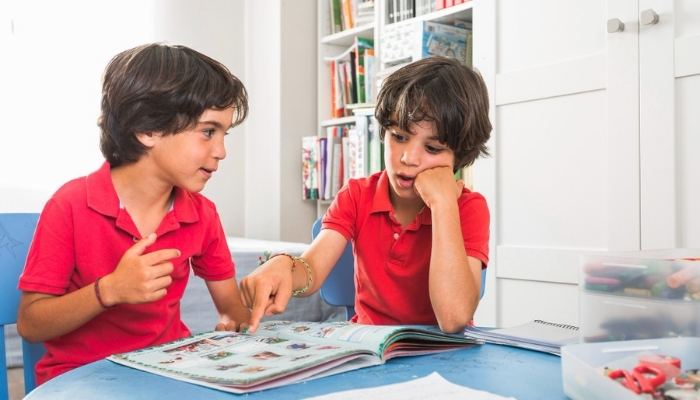Reading aloud can be challenging for children, especially when words don’t sound the way they are spelled. This often leads to hesitation, mispronunciations, and frustration for both kids and parents.
A common cause of these difficulties is the schwa sound, the unnoticed vowel that changes how many words are pronounced. Understanding this sound helps children make sense of why words are pronounced differently from their spelling.
In this guide, you’ll find clear examples of schwa in words and sentences, along with practical tips and activities that parents and teachers can use to support children in reading more confidently and naturally.
Key Takeaways
-
The schwa sound plays a central role in the rhythm and flow of English words.
-
Awareness of weak and strong syllables supports reading comprehension and pronunciation.
-
Accent variations alter how schwa is pronounced but do not change its fundamental function.
-
Consistent observation and practice help children internalize natural speech patterns.
What is the Schwa Sound?

The schwa is the most common vowel sound in English, a soft “uh” that appears in unstressed syllables, the quiet, weak parts of words.
The schwa sound is like the “lazy” cousin of all vowels. Imagine a vowel that’s just too tired to make any effort.
You can make the schwa sound by barely opening your mouth. Your tongue, lips, and jaw stay relaxed, and it comes out as a soft “uh.” Almost no energy needed!
For example:
-
About → the first “a” is unstressed: “uh-BOUT”
-
Sofa → the first syllable “so” is weak: “SO-fuh”
-
Banana → the first and last syllables relax into schwa: “buh-NA-nuh”
You’ll find it everywhere in English because it’s a stress-timed language. We emphasize the critical syllables and let the others relax. That’s why so many words, like sofa, banana, and chocolate, sneak in this lazy little “uh.”
However, seeing and hearing schwa is one thing, but understanding its role in English makes all the difference. Next, let’s explore why this lazy little vowel is so important for reading, speaking, and overall fluency.
Why Schwa Matters in English?
The schwa affects how your child develops reading fluency and natural pronunciation. Understanding its role helps you support their language growth more accurately.
Here's why the schwa is so important for your child:
-
Natural speech patterns emerge - Children sound more like native speakers when they use schwa correctly.
-
Reading becomes smoother - Kids don't get stuck trying to pronounce every vowel with full strength.
-
Spelling confusion reduces - Understanding weak syllables explains why some vowels seem "wrong".
-
Vocabulary expands more easily - Long words become less intimidating when children recognize schwa patterns.
-
Confidence builds naturally - Children stop worrying about "mispronouncing" words that follow schwa rules.
The schwa explains why "the" sounds like "thuh" in sentences. It shows why "chocolate" loses its middle "o" sound. These actually reflect the natural patterns of the English language.
Your child benefits from recognizing these patterns early. They can develop stronger decoding skills and feel more confident with challenging vocabulary.
While the schwa follows consistent rules, accents can still influence how it is pronounced. Understanding these variations helps clarify how children hear and produce this sound.
Also Read: How to Encourage Reading in Kids: Tips, Books, and Expert Guidance
Effect of Accents on Schwa Pronunciation

At large, the schwa sound follows the same basic rules across English, but its actual pronunciation can vary depending on the accent. Australian, British, and American English each handle schwa slightly differently, which can influence how children hear and produce the sound.
Here’s how the schwa gets affected in each of these accents.
American English Schwa Patterns
American speakers tend to make clearer, longer schwa sounds. Words like "about" and "support" have distinct "uh" sounds in unstressed syllables.
The American schwa often sounds closer to a short "u" sound. Children learning American pronunciation hear stronger schwa sounds in words like "banana" and "family."
British English Schwa Variations
British English sometimes shortens the schwa more than other accents. The sound becomes very quick and light in words like "chocolate" and "different."
Some British speakers almost skip the schwa entirely. The second "o" in "chocolate" might disappear altogether in casual speech.
Australian English Schwa Characteristics
Australian English has its own distinctive approach to the schwa sound. Australian speakers often make the schwa more precise and distinct than speakers of other English accents.
Words like "about" and "support" have distinctly audible schwa sounds in Australian pronunciation. The schwa rarely disappears completely in casual Australian speech.
Australian English also tends to replace r-controlled vowels with schwa sounds. Words like "letter," "winter," and "doctor" often sound like "lett-uh," "wint-uh," and "doct-uh" in Australian pronunciation.
Accent differences highlight subtle pronunciation shifts, but the core patterns remain the same. Let’s now look at some concrete examples to reinforce how the schwa functions in everyday language.
Examples of Schwa in Words and Sentences

Learning the schwa becomes crystal clear when you see real examples. The following demonstrations will show you how the schwa works in everyday words and natural speech.
Word Examples with Schwa
At the beginning of words:
-
About (uh-BOUT) - The "a" becomes a soft "uh" sound.
-
Ago (uh-GO) - Again, the "a" relaxes into schwa.
-
Around (uh-ROUND) - Same pattern with the first vowel.
-
Again (uh-GAIN) - Notice how natural this sounds.
-
Away (uh-WAY) - The "a" loses its strength.
-
Alone (uh-LONE) - Unstressed syllables become schwa.
In the middle of words:
-
Banana (buh-NAN-uh) - Two schwa sounds in one word!
-
Support (suh-PORT) - The "u" becomes schwa when unstressed.
-
Family (FAM-uh-lee) - The "i" turns into schwa.
-
Button (BUT-uhn) - The "o" relaxes to schwa.
-
Listen (LIS-uhn) - The "e" becomes the lazy sound.
-
Chicken (CHICK-uhn) - Another "e" to schwa example.
At the end of words:
-
Sofa (SO-fuh) - The "a" loses its punch.
-
Extra (EX-truh) - The "a" becomes soft and weak.
-
Pizza (PEET-suh) - The "a" turns to schwa.
-
Drama (DRAH-muh) - Same pattern here.
-
Zebra (ZEE-bruh) - The final "a" relaxes.
Words with multiple schwas:
-
Chocolate (CHOC-uh-luht) - Two schwa sounds make this word flow.
-
Camera (CAM-uh-ruh) - Both unstressed vowels become schwa.
-
Elephant (EL-uh-fuhnt) - The "e" and "a" both relax.
-
Yesterday (YES-tuhr-day) - The "e" becomes schwa.
-
Celebrate (CEL-uh-brayt) - The "e" in the middle syllable.
Sentence Examples for Practice
Practice these sentences with your child to hear schwa in natural speech:
-
The banana fell from the sofa yesterday.
-
My family went to revisit Grandma.
-
Can you support the camera on the extra table?
-
About ten children listened to the drama story.
-
I have an idea about fixing the broken button.
-
The elephant walked around the chocolate factory.
-
We celebrated with pizza and extra dessert.
-
Yesterday, the chicken went away from the garden.
These sentences contain multiple schwa sounds occurring naturally. Your child will naturally recognize how unstressed syllables flow together in connected speech as they practice.
Guide them in noticing how some words sound entirely different from their spelling. Explain that this is the schwa at work, helping English flow smoothly. Once the schwa is observed in real words and sentences, it becomes easier to approach teaching it. Using practical methods for teaching it can turn schwa recognition into fluent use.
Also Read: Effective Reading Comprehension Strategies for Kindergarten Students
How to Teach Schwa with Examples?

Teaching the schwa requires a gentle, step-by-step approach that builds understanding naturally. You want your child to hear patterns without feeling overwhelmed.
Here are proven methods that you can use to make schwa learning successful:
Step 1: Introduce the Concept as "Lazy Vowels"
Start by explaining that some vowels get tired and make a soft "uh" sound instead of their usual sound. This makes the concept friendly and memorable.
Show your child how to make the schwa sound. Keep your mouth barely open and let out a relaxed "uh." Compare this to the effort needed for strong vowel sounds.
Use the schwa symbol (ə) and explain that it looks like a tired "e" that fell over. Children love this visual connection.
Step 2: Practice with "Robot Voice" versus "Natural Voice"
Teach your child to read words in two ways. First, use "robot voice" where every syllable gets equal stress. Then switch to natural voice.
Try "banana" in robot voice: "BAH-NAH-NAH." Then say it naturally: "buh-NAN-uh." Your child hears the difference immediately.
This comparison makes the schwa concept obvious. Children understand why words sound different from their spelling.
Step 3: Start with Familiar Two-Syllable Words
Begin with words your child already knows and uses daily. Familiar vocabulary makes learning feel easier and more relevant.
Words like "about," "away," and "again" work perfectly. Your child recognizes these words but may not have noticed the schwa pattern.
Practice saying these words while tapping syllables. The stressed syllable receives a firm tap, while the schwa syllable receives a gentle tap.
Step 4: Use Syllable Stress Exercises
Teach your child to identify strong and weak syllables by clapping or tapping. Strong syllables get loud claps, weak syllables get soft taps.
Try this with words like "support," "famous," and "children." Your child learns to feel the rhythm of English stress patterns.
This physical activity makes the concept concrete and memorable. Children understand stress through movement and sound.
Step 5: Introduce Multi-Schwa Words Gradually
Once your child masters simple examples, move to words with multiple schwa sounds. Build complexity slowly to maintain confidence.
Words like "chocolate," "elephant," and "camera" contain multiple weak syllables. Break these words into parts and practice each syllable.
Show how all the unstressed syllables become schwa sounds. This reinforces the pattern while tackling more advanced vocabulary.
Step 6: Connect to Reading and Spelling
Apply schwa knowledge during regular reading time. Point out schwa sounds when they appear in stories or homework.
Explain that schwa helps with spelling by showing which vowels might be tricky to remember. The weak syllables often contain the challenging letters.
This connection makes schwa learning practical and useful for daily reading tasks.
By following these step-by-step teaching methods, you can help your child understand schwa patterns clearly and confidently. To reinforce this learning, incorporate engaging activities to practice the sound in enjoyable, memorable ways.
Fun Activities to Practice Schwa

Engaging activities can further make schwa practice enjoyable while reinforcing essential concepts. These games turn learning into play while building phonetic awareness.
Schwa Detective Game
Turn your child into a schwa detective! Create word cards and let them hunt for schwa sounds hidden in different words.
Mix schwa words with non-schwa words and place the cards face down. Your child flips cards and identifies which ones contain the lazy vowel sound.
Keep score and celebrate successful discoveries. This game builds recognition skills while maintaining excitement and engagement.
Syllable Clapping Songs
Create simple songs using words with clear schwa patterns. Clap loudly for stressed syllables and softly for schwa syllables.
Try singing "The schwa sound goes uh-uh-uh, all around the words we say." Use familiar tunes like "The Wheels on the Bus."
This musical approach helps children internalize stress patterns while having fun. Rhythm and melody make learning memorable.
Word Family Sorting
Collect words with schwa in different positions (beginning, middle, end). Sort them into groups based on where the schwa appears.
Use magazines or books to find real examples. Your child cuts out words and places them in the correct category.
This hands-on activity reinforces schwa positions while developing classification skills. Children see patterns across different word types.
Schwa Bingo
Create bingo cards filled with words that contain the schwa sound. Call out words and have your child identify if they contain schwa sounds.
Instead of marking squares randomly, players must listen carefully to each word and identify it accurately. This develops auditory discrimination skills.
Make multiple cards with different schwa words to extend the game. Winners can read their schwa words aloud for extra practice.
Stress Pattern Dance
Create simple dance moves for stressed and unstressed syllables. Strong syllables undergo significant movements, while schwa syllables undergo small ones.
Use words like "elephant" and "chocolate" to practice the dance patterns. Your child moves while saying the words.
This physical activity helps kinesthetic learners understand stress patterns. Movement reinforces auditory learning through body engagement.
Schwa Word Building
Begin with base words and demonstrate how adding syllables produces schwa sounds. Use word families to demonstrate patterns.
Show how "photo" becomes "photograph" and how "photography" changes stress patterns. The same letters make different sounds.
This morphological approach connects schwa to vocabulary development. Children see how word structure affects pronunciation.
Daily Schwa Hunts
During regular activities, point out schwa words you encounter together. Shopping lists, road signs, and book titles provide natural examples.
Make it a game to spot schwa words during car rides or walks. Your child develops automatic recognition skills.
This real-world application makes schwa learning practical and relevant. Children see how the concept applies beyond practice sessions.
Hands-on activities i ndeed make learning engaging, but consistent practice and targeted strategies can help solidify schwa recognition over time.
Tips for Learning and Practicing Schwa

Supporting your child's schwa development requires practical strategies that fit naturally into daily routines. These approaches address common learning challenges while maintaining motivation.
Here are some methods that accelerate schwa mastery:
-
Keep practice sessions short and positive - Five to ten minutes works better than long, intensive lessons.
-
Focus on listening first - Children need to hear schwa patterns before they can produce them consistently.
-
Use familiar vocabulary initially - Start with words your child already knows and uses regularly.
-
Make stress patterns physical - Clap, tap, or move to help children feel syllable differences.
-
Connect to meaningful reading - Point out schwa sounds during story time and homework sessions.
-
Celebrate small victories - Acknowledge when your child correctly identifies or produces schwa sounds.
-
Be patient with spelling - Understanding schwa helps with spelling, but mastery takes time and practice.
-
Use memory tricks for tricky words - Create associations or mnemonics for difficult schwa spellings.
-
Practice with word families - Group similar schwa patterns together for easier recognition
-
Record and playback - Let your child hear their own pronunciation progress over time
-
Make it social - Include siblings or friends in schwa games and activities.
-
Connect to child's interests - Use schwa words from topics your child enjoys
Remember that schwa recognition develops gradually. Some children pick up patterns quickly, while others need more repetition and support. Your consistent encouragement makes the most significant difference.
The goal is natural, fluent reading rather than perfect pronunciation analysis. Children who understand schwa become more confident readers and speakers.
Common Challenges While Teaching Schwa and How to Solve Them

Teaching the schwa sound presents specific obstacles that many families encounter. Recognizing these challenges helps you prepare effective solutions and maintain progress.
Let's tackle the most frequent difficulties with practical approaches:
Challenge 1: Child Cannot Hear the Schwa Sound
Many children struggle to distinguish the subtle schwa from other vowel sounds. Their ears need training to catch this weak, unstressed sound.
Solutions that work:
-
Begin with exaggerated examples where the contrast is immediately apparent.
-
Use the "robot voice" technique to highlight the difference between spelled and natural pronunciation.
-
Practice with word pairs like "photograph" vs. "photography" where stress shifts change the sounds.
-
Begin with listening-only exercises before asking for production.
-
Record natural speech and play it back slowly so children can hear the patterns.
Challenge 2: Confusing Schwa with Short U Sound
The schwa and short "u" sound very similar, making identification difficult for many learners. This confusion is entirely usual.
Effective approaches include:
-
Direct comparison exercises between words with schwa and short "u".
-
Visual stress marking to show which syllables are weak versus strong.
-
Listening games that focus specifically on stress patterns rather than individual sounds.
-
Practice with words where the contrast is clearest.
-
Patient repetition without pressure or correction overload.
Challenge 3: Skipping Schwa Syllables When Reading
Children often omit unstressed syllables entirely, saying "choc-late" instead of "choc-o-late" or skipping the schwa altogether.
Helpful strategies involve:
-
Syllable counting exercises before reading multisyllabic words.
-
Physical tapping or clapping for each syllable to maintain awareness.
-
Breaking long words into smaller chunks for practice.
-
Using finger counting to track each syllable.
-
Reading along with audio recordings that model proper syllable timing.
Challenge 4: Inconsistent Practice and Motivation
Maintaining regular schwa practice can be challenging when children lose interest or forget to apply their learning.
Motivation techniques include:
-
Incorporating schwa activities into favorite games and interests.
-
Setting small, achievable daily goals rather than overwhelming yourself with long sessions is a good approach.
-
Creating reward systems for consistent effort rather than perfect performance.
-
Making practice social by involving family members or friends.
-
Connecting schwa learning to real-world reading success stories.
Challenge 5: Accent and Dialect Differences
Children from different linguistic backgrounds may pronounce schwa sounds differently, which can lead to confusion about the "correct" pronunciation.
Inclusive solutions involve:
-
Acknowledging that accent variation is normal and valuable.
-
Focusing on the stress pattern concept rather than exact sound production.
-
Providing examples from multiple accent types when possible.
-
Emphasizing that clear communication is more important than matching accents.
-
Celebrating linguistic diversity while teaching general patterns.
Understanding these challenges helps you support your child more successfully. Most difficulties are resolved with the patient through consistent practice and the use of appropriate strategies.
The key insight is that pronunciation learning happens gradually. Your supportive attitude and creative problem-solving matter more than perfect technique or immediate results.
Conclusion
The schwa sound shapes how your child reads and speaks English naturally. This lazy vowel cousin appears in most multisyllabic words your child encounters on a daily basis.
Teaching the schwa requires patience, creativity, and consistent practice. Begin with simple examples of schwa and gradually build complexity through engaging activities and games.
However, sometimes you might find it challenging to explain pronunciation concepts to your kid. That’s when professional guidance can accelerate your child's progress while building confidence in foundational skills.
FunFox Program understands how to make complex language concepts accessible and enjoyable for primary school students. Our experienced teachers utilize proven methods to establish a strong literacy foundation.
Our comprehensive approach addresses pronunciation challenges systematically:
-
Writers Club builds spelling confidence by teaching sound-letter relationships, including tricky schwa patterns.
-
Readers Club develops reading fluency through guided practice with natural pronunciation.
-
Small-group instruction provides personalized attention to meet individual learning needs.
-
An interactive online format makes expert teaching accessible from anywhere.
-
Proven teaching methods combine phonetic instruction with engaging, age-appropriate activities.
The FunFox Way transforms challenging concepts, such as schwa, into manageable and enjoyable learning experiences. Your child will receive professional support as they develop essential reading and pronunciation skills.
So, give your child the support they need to master reading and pronunciation with confidence. Join the FunFox Program today and let our experienced teachers guide you through engaging lessons and activities that make learning fun and fruitful.
FAQ’s
1. What is the rule for the schwa sound?
English uses the schwa in unstressed syllables. Any vowel can become a schwa depending on word stress and syllable position, producing a short, neutral “uh” sound.
2. Why is it called a schwa sound?
Linguists named it after the Hebrew “shva” symbol, which represents a neutral vowel. It denotes minimal vocal effort in unstressed syllables.
3. What is a list of schwa words?
Words like again, ago, alone, support, elephant, camera, banana, and pizza contain vowels that reduce to the soft schwa sound.
4. How to identify a schwa?
Listen for weak, unstressed syllables. When vowels sound short, neutral, or minimal, they function as a schwa regardless of spelling.
5. How is a schwa taught in phonics?
Teachers guide learners with listening exercises, word sorting, and stress marking. Students practice contrasting full vowels with schwa sounds to recognize and pronounce them correctly.














